Olibanum, Frankincense, Ru Xiang 乳香Also called Thus, LibanosRu Xiang (TCM) Shallaki (Ayurveda) Kundur (Unani) Spos dkar སྤོས་དཀར (Tibetan) |

|

|
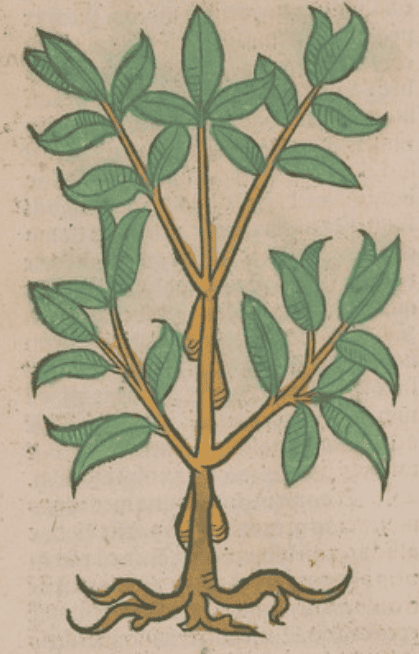
|
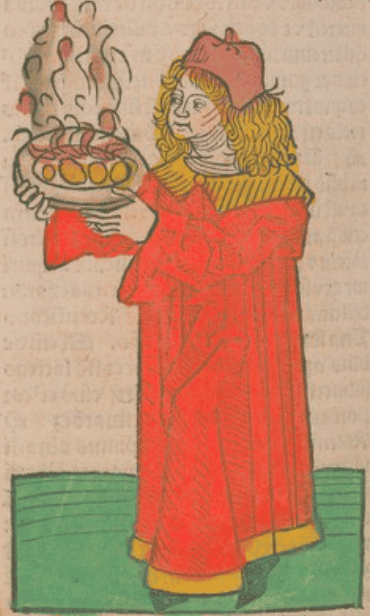
|
Ortus Sanitatis, Meydenbach, 1491
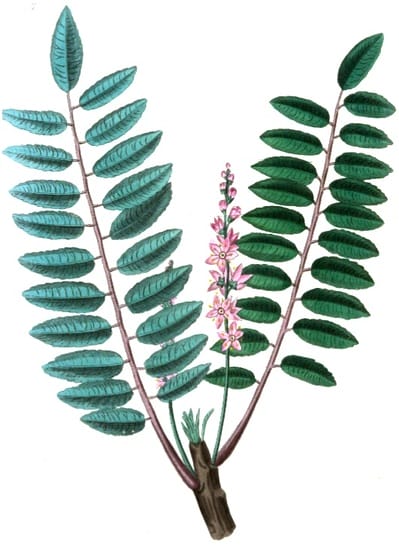 Boswellia Serrata
Boswellia SerrataMedical Botany, Stephenson and Churchill, 1836
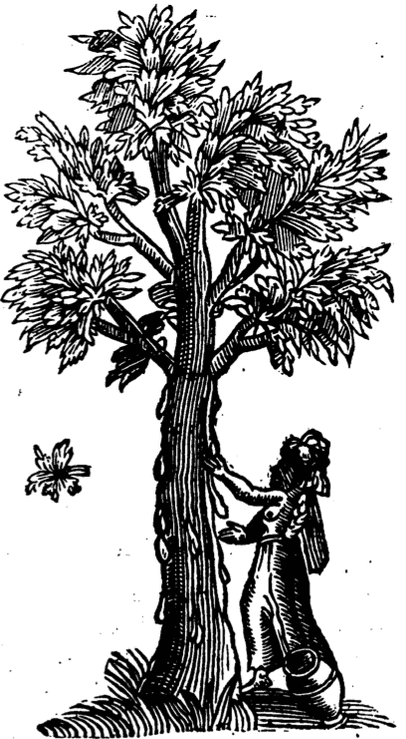 Frankincense tree (Parkinson, Theatrum Botanicum, 1640)
Frankincense tree (Parkinson, Theatrum Botanicum, 1640) |
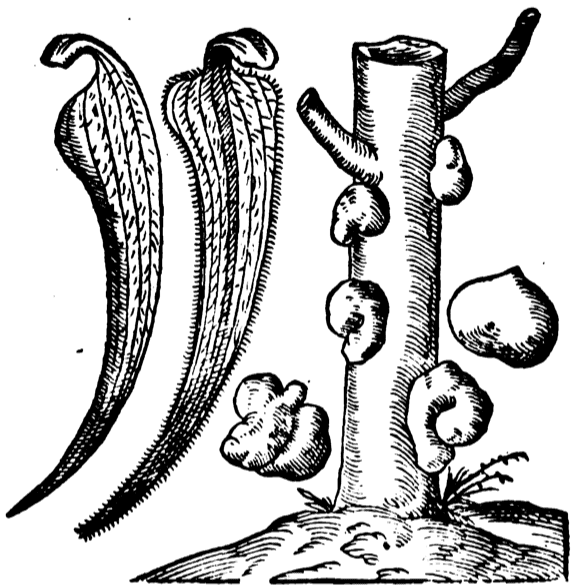 Herbarium, Matthioli (Polish), 1596
Herbarium, Matthioli (Polish), 1596 |
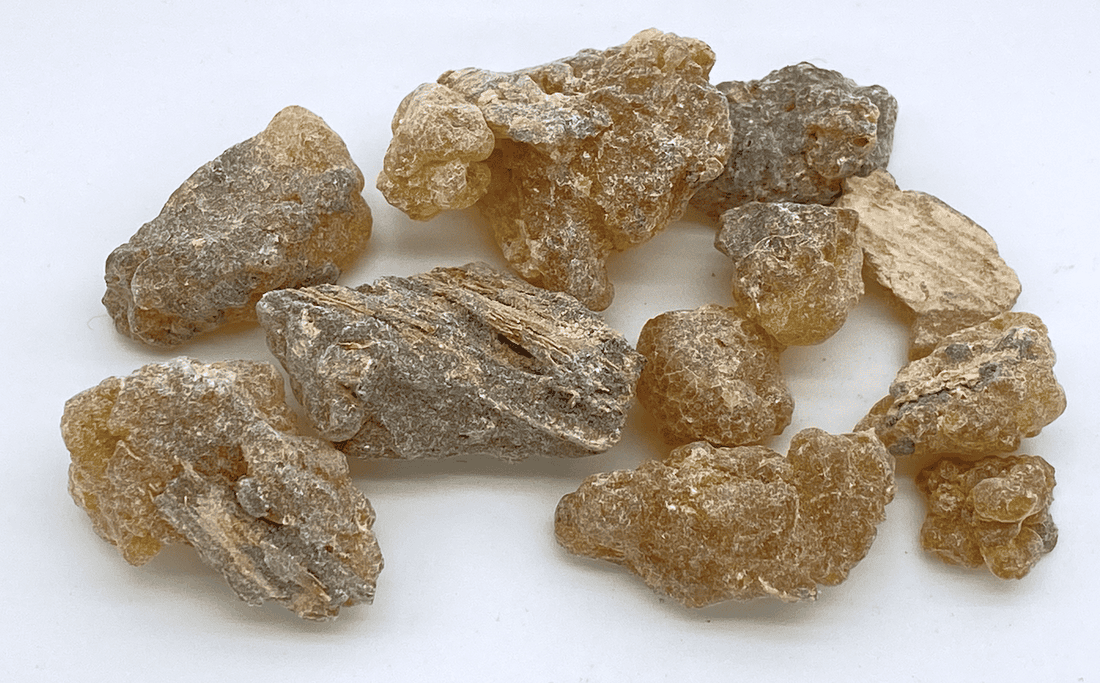 Frankincense (Adam, 2022)
Frankincense (Adam, 2022)Botanical name:
Boswellia spp.
Frankincense is often divided into types based on the source:
- African Frankincense: B. papyrifera, B. frereana (sometimes B. sacra)
- Arabian Frankincense: B. sacra (syn. B. carterii)
- Indian Frankincense: B. serrata (syn. B. thurifera)
Another popular species is B. dalziliee which produces a green resin.
Parts used:
Gum
“Male frankincense, which is white in colour, round in shape and has a sticky interior, is considered best. On breaking the internal portion appears to be golden in colour”. (Avicenna)
Classically in the West, 2 main varieties were recognised:
- ‘Male’, called Olibanum (classically, mostly B. papyrifera)
- ‘Female’, called Thus.
- Lubãn Dhakar: B. sacra (from Southern Arabia)
- Mohr: B. carterii (Somalia, Southern Arabia; most common Frankincense)
- Lobãn Majdi: B. frereana (Somalia; best quality and most expensive)
- Boido: Boswellia papyrifera (East Africa)
- Salai Guggul: B. serrata
- Kundur Zakar (Male Frankincense): deep yellow tears
- Kundur Unsa (Female Frankincense): pale tears
- Kundur Madahraj: artificial tears formed by shaking the moist exudate in a basket
- Kisbar Kundur or Kashfa: tree bark coated in Frankincense
- Dukak Kundur: dust of Olibanum
Temperature & Taste:
Warm, dry. Pungent, sweet, bitter.
“Frankincense is hot in the second and dry in the first degree” (Avicenna)
Constituents:
Monoterpenes: β-pinene (to 25%), sesquiterpenes, monoterpenols, sesquiterpenols
Incensole acetate
Boswellic acids
Classifications:
2D ATTENUATERS OF CONGEALED BLOOD. 2G. CLEANSING. 2O. ASTRINGENT. 2P. HEMOSTATIC. 2Q. ANODYNE. 2T. GLUTINATE.
2U. SUPPURATIVE. 2W. SARCOTIC. 2X. INCARNATIVE
3B. FEBRIFUGE & ANTIPYRETIC. 3D. CORDIALS & CARDIACS. 3G. EMMENAGOGUE. 3I. APHRODISIAC. 3L. ANTI-TUSSIVE. 3M. ARTHRITICS
4c. CARDIAC. 4e. STOMACHIC
Uses:
1. Moves the Blood, Promotes Healing, Eases Pain (TCM, Ayurveda, West):
-Bruising, pain from Trauma;
-chest and abdominal pain from congealed and sluggish blood flow.
-early stages of carbuncles, sores, and swellings.
-“expels Pus and Toxin by strengthening Qi [of the Blood]” (TCM: Li Shi Zhen)
-internal excoriations; Coughing of Blood, Vomiting of Blood
-strengthens the Heart and circulation
-“relieves pain of all Channels” (TCM: Zhang Yuan Su)
-“Good for helping Birth” (TCM: Li Shi Zhen)
2. Clears the Circulation, Relaxes the Tendons and Ligaments (TCM, Ayurveda, West):
-chronic pain from wind/cold/damp, which is especially seen in the joints.
-Rigidity; Spasms; stiffness of the sinews and ligaments.
-relaxes the tendons to improve flexibility
-“activates the Blood circulation, relieves Pain and stretches the Tendon” (TCM: Li Shi Zhen)
3. Settles Wind, Benefits the Brain and Senses:
-‘Strengthens the Memory exceedingly, comforts the Heart, expels Sadness and Melancholy.’ (Culpeper)
-‘It driveth away dimness of eye-sight’ (Gerard).
–Avicenna said it strengthens Wit and understanding.
–Hildegard said it ‘clears the Eyes and purges the Brain’ … but its odor ‘will strengthen you … and fill your Brain’.
–Ayurveda also recognise it as a brain tonic in mental weakness, and regards it as Rejuvenative; these effects relate to its effect in moving and regulating the blood.
-regarded as strengthening to the Vital Organs, and increasing Vitality (Unani)
-“brings down adverse ascending Qi” (TCM: Da Ming); “It treats Insomnia” (Xu Zhi Cai)
-“Deafness, Apoplexy with Lockjaw and Aphasia” (TCM, Chen Cang Qi)
4. Clears Phlegm and Damp:
-clears Cholesterol and Arteriosclerosis
-long term use helps treat Obesity (Unani)
-helps clear Phlegm from the Lungs; stops Cough
-“useful for treating Phlegmatic Fevers” (Avicenna)
-disorders of Serum (Chu ser) in Tibet
-“good for treating edema due to Wind evil” (TCM: Ming Yi Bie Lu)
5. Benefits the Stomach:
-“stops Vomiting and even Vomiting of Blood” (Avicenna)
-“strengthens the Stomach and restore its normal tone”. (Avicenna)
-“highly warming for the Stomach and facilitates Digestion”. (Avicenna)
-“Frankincense stops diarrhea” (Avicenna)
5. Externally (TCM, Ayurveda, West):
-Bruising, Trauma
-topically for swelling and pain, to promote healing and the generation of flesh in Wounds and Ulcers.
-powder can be sprinkled on to stop bleeding
-sores, carbuncles, pyogenic infections.
-infections of the skin which are not healing.
-redness, swelling and pain of the mouth, gums, and throat.
-chewed to relieve foul breath
-It ‘stayeth all corruptions of Blood, although it fall from the Head’ (Gerard).
–‘Helps green wounds, and fills hollow ulcers with flesh, stops the bleeding of wounds, though the arteries be cut’ (Culpeper).
-“heals the ulcers caused by Burns”. (Avicenna)
-collyrium with honey for Pterygium and Conjunctivitis (Unani)
-Galen used it for Ulcers of the Eyes.
-“an important drug meant to be used in red and chronic Pterygium and also for treating Cancer of the eye.” (Avicenna)
-smoke is inhaled for Bronchitis (Ayurveda)
-more recently been used in wrinkle creams. (Raw Frankincense is used externally)
-mixed in coconut oil to promote hair growth (Unani)
-applied to Inflammations, Swellings and Tumors
-Breast Swelling in breastfeeding women (Matthiolus)
-stiffness of the Sinews, Cramping and Spasms
-burned to purify the air during infectious and epidemic diseases and to “repel all Evil”
Dose:
Powders: 300mg–2 grams
Decoction: 3–9 grams
Comment:
“Ru Xiang [Frankincense] is used as a food substitute. People will not get hungry even without eating”. (TCM: Li Xun)
Preparation:
In TCM, the raw product is generally only used externally; it is prepared for internal use.
1. Dried Frankincense:
“Ru Xiang (Frankincense) is very greasy and difficult to grind. Before it is ground, keep the drug in a bag and hang it by the window for a long time. Then, it becomes easier to grind and no longer greasy.” (TCM, Su Song)
2. Stir-fried Frankincense:
Stir-fried in a wok until it swells a little and becomes yellow-brown and aromatic. This is more gentle on the Stomach and is more warming, so better for Wind-Cold-Damp pain and to move the Blood when associated with Cold. It also facilitates pulverisation. (TCM)
3. Vinegar Stir-fried Frankincense:
Stir-fried with Vinegar is strongest to move the Blood and relieve pain. Used for severe chest or abdominal pain from Blood stagnation, amenorrhea, postpartum pain etc. (TCM)
4. Wine-prepared Frankincense:
Grind the gum into a paste with alcohol, then dry in the sun. Preparing with wine helps move the Blood, makes it easier to digest and is also more warming than the raw product. This also facilitates grinding into powder.
5. Soot of Frankincense:
The soot collected from Burning Frankincense was occasionally used by the ancient Greeks: ‘grasping with a pair of tweezers one lump of frankincense at a time and after holding it close to a flame, place it in a hollow, new pan; cover it with a concave brazen lid perforated in the middle and carefully cleaned, and place under one of its sides or under both sides small stones four fingers high to reveal whether it bums and to create a space for adding ever more lumps; before the first lump is completely burned add another until you think enough soot has been collected. But make sure to wipe continuously all around the external parts of the brazen lid with a sponge of cold water; this way all soot settles on the lid, because it is not very hot; otherwise it falls down on account of its lightness and it gets mixed with the ash of the frankincense’.
‘Therefore, scraping off the first soot, repeat the process as long as you think that you need to, and move aside the ash of the frankincense that was thoroughly burned. It is capable of soothing 1nflammations of the eyes, checking discharges, cleansing sores, filling cavities, and stemming erosive sores. Soot of myrrh, of resin, and of storax are similarly prepared. They are suitable for the same Purposes.’ (Dioscorides)
Correctives:
1. Saffron (Unani)
2. Tragacanth (Unani)
Substitutes:
1. Mastic & Indian Bdellium (Guggulu) are accepted substitutes in Unani.
2. Myrrh is used similarly, but is heavier and less ethereal than Frankincense.
Adulteration:
“It is adulterated with different kinds of gums and pine resin. Frankincense is inflammable on contact with fire while the pine resin gives only smoke. Hence all the adulterated varieties of frankincense do not catch fire”. (Avicenna)
Main Combinations:
Myrrh & Frankincense
Often used with Myrrh. Combined for all types of pain from Blood stagnation; Trauma, Angina Pectoris, chronic Joint disease, Gynecological disorders associated with Blood stagnation, and for masses and Tumors. Commonly used internally and externally.
Move the Blood
1. Internal bruising with fixed pain, Blood stagnation, Trauma:
i. Frankincense with Myrrh, Dragon’s Blood, Safflower, Borneol Camphor, Musk. (as in Qi Li San)
ii. Frankincense with Myrrh, Dragons Blood, Saffron (as in Powder to Move Blood)
iii. Frankincense with Nux Vomica, Ephedra, Myrrh (as in Jiu Fen San of TCM)
iv. Frankincense, Myrrh, Salvia Dan Shen, Dang Gui (as in Huo Luo Xiao Ling Dan of TCM)
v. Frankincense with Amber, Madder, Comfrey, Myrrh
vi. Frankincense, Madder, Rhubarb, Saffron, Shilajit
2. Chest and Abdominal pain from Blood stagnation:
i. Frankincense with Corydalis Yan Hu Suo.
ii. Frankincense with Safflower (Hong Hua), Salvia Dan Shen, Costus Mu Xiang
3. Cholesterol, Arteriosclerosis:
i. Frankincense, Myrrh, Safflower
ii. Frankincense with Turmeric, Ginger
Gynecology and Obstetrics:
4. Promote Menstruation, Franklincense, Cyperus rotundus, Licorice
5. Dysmenorrhea:
i. and Uterine Fibroids, Frankincense, Asparagus racemosus, Rose, Safflower (Ayurveda)
ii. Frankincense, Dang Gui, Safflower (Hong Hua), Peach kernel (Tao Ren) (TCM)
6. Uterine Tumors, Frankincense, Peach kernel (Tao Ren), Safflower (Hong Hua), Zedoary (E Zhu)
7. To prepare for Labor: Frankincense (1 part), Bitter Orange (Zhi Ke) (2 parts). Powder and make small Honey pills the size of a parasol seed. Take 30 pills with wine before a meal in the last month of Pregnancy. These pills were called Shen Qi Wan. (TCM: Fu Ren Da Quan Liang Fang)
Lungs
8. Chronic Cough, Breathlessness, Frankincense with Myrrh, Licorice, Saffron.
9. Hemoptysis, Frankincense with Licorice and Gum Arabic. (Saunders)
10. Pleurisy, Lung Abscess, core an Apple, put Frankincense in and seal with the apple piece removed; bake, and eat.
Memory
11. To increase Memory:
i. “strengthens the memory when used by taking its infusion regularly on an empty stomach” (Avicenna)
ii. Frankincense with Calamus
iii. Frankincense with Black Pepper (as in Powder of Frankincense and Pepper)
iv. Strengthen Brain and Heart, benefit Memory, take Frankincense with Conserve of Rose
v. Frankincense with Black Pepper, Cyperus rotundus. Myrrh (as in Electuary of Frankincense of Wirtzung)
vi. Frankincense with Cubeb, Calamus, Nutmeg, Clove, Myrrh (as in Pills to Increase Memory)
vii. Frankincense with Calamus, Cyperus rotundus, Ginger, Black Pepper (as in Electuary for Amnesia of Unani)
viii. Frankincense with Rosemary, Marjoram, Sage, Betony, Balm, Peony, Zedoary, Caraway, Nutmeg, Licorice (as in Powder of Great Use Against Forgetfulness)
Urinary, Joint:
12. Urinary Incontinence:
i. Frankincense with Cyperus rotundus, Acorn, Costus, Ginger, Black Pepper (as in Electuary of Frankincense of Unani)
ii. Frankincense with Acorn, Myrrh, Rue, Calamus (as in Powder for Incontinence of Alexander Benedictus)
iii. Frankincense with Comfrey, Cyperus rotundus, Galangal, Plantain, Horsetail, Acorn cup, Rue seed, Agnus Castus (as in Wine for Incontinence)
13. Joint Pain, Arthritis, Rheumatoid Arthritis from Wind-Damp with Blood Stagnation:
i. Frankincense, Turmeric (this combination has been studied and found effective in Osteoarthritis)
ii. Rheumatoid arthritis; Osteoarthritis; Cervical and lumbar spondylosis; Trauma, Bursitis, Frozen Shoulder, Frankincense with Bdellium (Guggulu) (This is marketed as Rumalaya Forte)
iii. Frankincense with Bdellium, Myrrh, Turmeric
iv. Frankincense with Cyperus rotundus Xiang Fu, Rhubarb (Da Huang), Costus (Mu Xiang)
v. Frankincense with Dang Gui, Notopterygium Qiang Huo, Gentiana macrophylla Qin Jiao (TCM)
vi. Frankincense with Myrrh, Aconitum Cao Wu, Aconitum Chuan Wu, Arisaema Tian Nan Xing, Earthworm (Di Long) (as in Xiao Huo Luo Dan)
vii. Frankincense with Triphala, Tinospora, Costus, Cassia seed, Adhatoda vasica, Shilajit (as in Frankincense 10 (Spos dkar 10) of Tibetan Medicine)
Other:
14. Impotence, Frankincense, Withania, Tinospora (Ayurveda)
15. Diabetes:
i. Frankincense with Acorn, Coriander, Gum Arabic, Armenian Earth (as in Powder for Diabetes)
ii. Frankincense, Milk Thistle seed, Nettle (this combination has been studied and found effective)
Externally:
16. Topically for Wounds and Bleeding, apply powder Frankincense with Aloe (as in Pulvis Thuraloes, Powder of Frankincense and Aloes)
17. Inflammations of the Breast, Frankincense, Cimolian Earth and oil or Ointment of Roses (Dioscorides, Avicenna)
18. “Incorporated in the plasters which are made to dissolve the inflammation of viscera” (Avicenna)
19. “Prevents the spread of Malignant Ulcers” (Avicenna)
20. Topically for Cancer, boil Frankincense down in wine with honey and apply topically.
21. To heal old or new Wounds, Headache, stiffness of the Sinews, aches and pain, and various skin disorders, Frankincense with Mastic, Camphor made into a salve with Rosin, Wax and Suet.
22. Wound healing ointment:
i. Frankincense, Myrrh, Aloe (Traditional Iranian Medicine)
ii. Frankincense, Myrrh, Dragon’s Blood, Catechu (Jin Chuang Ointment, TCM)
23. Vaginal suppositories in abscess, adnexitis, and salpingitis, Olibanum, Galbanum and Myrrh (1 part each), Cocoa butter (10 parts) (Köhler)
24. Topically for Toothache, Frankincense with Stavesacre (Galen)
25. Mouth Ulcers or Gums Boils, apply powder of Myrrh, Gall and Frankincense bark (or Gum) mixed with Honey (Avicenna)
26. “It heals and fills up Ophthalmic Ulcers” (Avicenna)
27. Burns and Chilblains, Frankincense is applied with Goose or Pork fat (Dioscorides)
28. Whitlow, Frankincense is applied with Honey (Dioscorides)
29. Ringworm, apply with Duck fat. (Avicenna)
30. Dandruff: “Sometimes it is applied with sodium nitrate to remove the Dandruff and dry up the Ulcers” (Avicenna)
31. Diseases of the Ears, boil Frankincense in wine and drop in the ears warm (Dioscorides, Avicenna)
Major Formulas
Electuary of Frankincense (Zenon)
Electuary of Frankincense (Wirtzung)
Electuary of Frankincense (Unani)
Electuary for Amnesia (Unani)
Electuary for Memory (Wirtzung)
Powder for Diabetes (Wirtzung)
Powder to Move Blood (Wirtzung)
Powder of Frankincense and Pepper (Wirtzung)
Powder for Incontinence (Rhasis)
Powder for Incontinence (Alexander Benedictus)
Powder for Hollow Wounds (Wecker)
Powder for Vomiting from Heat
Powder for Wounds
Trauma Powder
Troches of Winter Cherry (Trochisci Alkekengi) (Mesue)
Beautiful Anodyne Antidote
Confection for all Diseases of the Eyes
Electuary for Back Pain (Galen)
Pills for Asthma and Shortness of Breath (Unani)
Pills for Catarrh
Pills for Excess Menstruation (Gabelhover)
Pills of Sarah (Unani)
Pills of Storax (Mesue)
Pills to Stop Bleeding
Plaster of Bayberries (Mesue)
Su He Xiang Wan
Feng Shi Ma Qian Pian
Xiao Huo Luo Wan
Huo Luo Xiao Ling Dan
Juan Bi Tang
Qi Li San
Xi Huang Wan
Shi Xiang Fan Sheng Wan
Jiu Fen San
Die Da Wan
Bi Ma La (Tibetan)
Frankincense 10 (Spos dkar 10) (Tibetan)
Undying Aloeswood 8 (Chi med a gar brgyad pa) (Tibetan)
Cautions:
1. Not used during Pregnancy
2. Not used for Suppurating Boils (TCM)
3. “Its excessive use ‘burns’ the blood” (Avicenna)
4. “Its excessive use may, however, cause Headache” (Avicenna)
5. “Excessive oral intake with wine may be fatal” (Avicenna)
Main Preparations used:
|
‘The use of olibanum goes back to a period of extreme antiquity, as proved by the numerous references in the writings of the Bible to incense, of which it was an essential ingredient. It is moreover well known that many centuries before Christ, the drug was one of the most important objects of the traffic which the Phoenicians6 and Egyptians carried on with Arabia. Professor Diimichen of Strassburg has discovered at the temple of Dayr el Bahri in Upper Egypt, paintings illustrating the traffic carried on between Egypt and a distant country called Punt or Pount as early as the 17th century B.C. In these paintings there are representations not only of bags of olibanum, but also of olibanum trees planted in tubs or boxes, being conveyed by ship from Arabia to Egypt. Inscriptions on the same building, deciphered by Professor D., describe with the utmost admiration the shipments of precious woods, heaps of incense, verdant incense trees, ivory, gold, stimmi (sulphide of antimony), silver, apes, besides other productions not yet identified. The country Pount was first thought to be southern Arabia, but is now considered to comprehend the Somali coast, together with a portion of the opposite Arabian coast. Punt possibly refers to “Opone,” an old name for Hafoon, a place south of Cape Gardafui. A detailed account of frankincense is given by Theophrastus (B.C. 370-285) who relates that the commodity is produced in the country of the Sabffians, one of the most active trading nations of antiquity, occupying the southern shores of Arabia. It appears from Diodorus that the Sabaeans sold their frankincense to the Arabs, through whose hands it passed to the Phoenicians who disseminated the use of it in the temples throughout their possessions, as well as among the nations with whom they traded. The route of the caravans from south-eastern Arabia to Gaza in Palestine, has recently (1866) been pointed out by Professor Sprenger. Plutarch relates that when Alexander the Great captured Gaza, 500 talents of olibanum and 100 talents of myrrh were taken, and sent thence to Macedonia. |
The libanotophorous region of the old Sabaeans is in fact the very country visited by Carter in 1844 and 1846, and lying as he states on the south coast of Arabia between long. 52°’ and 52° ‘ east. It was also known to the ancients, at least to Strabo and Arrian, that the opposite African coast likewise produced olibanum, as it is now doing almost exclusively; and the latter states that the drug is shipped partly to Egypt and partly to Barbaricon at the mouth of the Indus. As exemplifying the great esteem in which frankincense was held by the ancients, the memorable gifts presented by the Magi to the infant Saviour will occur to every mind. A few other instances may be mentioned: Herodotus relates that the Arabians paid to Darius, king of Persia, an annual tribute of 1000 talents of frankincense. A remarkable Greek inscription, brought to light in modern times6 on the ruins of the temple of Apollo at Miletus, records the gifts made to the shrine by Seleucus II., King of Syria (B.C. 246-227), and his brother Antiochus Hierax, king of Cilicia, which included in addition two vessels of gold and silver, ten talents of frankincense and one of myrrh. The emperor Constantino made numerous offerings to the church under St. Silvester, bishop of Rome A.D. 314-335, of costly vessels and fragrant drugs and spices, among which mention is made in several instances of Aromata and Aromata in incensum, terms under which olibanum is to be understood. With regard to the consumption of olibanum in other countries, it is an interesting fact that the Arabs in their intercourse with the Chinese, which is known to have existed as early as the 10th century, carried with them olibanum, myrrh, dragon’s blood, and liquid storax, drugs which are still imported from the west into China. The first-named is called Ju-siang [Ru Xiang], i.e. milk perfume, a curious allusion to its Arabic name Luban signifying milk. In the year 1872, Shanghai imported of this drug no less than 1,360 peculs (181,333 lb.)’. (Pharmacographia, Fluckiger & Hanbury, 1879) |
